一、决策树
定下一个最初的质点,从该点出发、分叉。(由于最初质点有可能落在边界值上,此时有可能会出现过拟合的问题。
二、SVM
svm是除深度学习在深度学习出现之前最好的分类算法了。它的特征如下:
(1)它既可应用于线性(回归问题)分类,也可应用于非线性分类;
(2)通过调节核函数参数的设置,可将数据集映射到多维平面上,对其细粒度化,从而使它的特征从二维变成多维,将在二维上线性不可分的问题转化为在多维上线性可 分的问题,最后再寻找一个最优切割平面(相当于在决策数基础上再寻找一个最优解),因此svm的分类效果是优于大多数的机器学习分类方法的。
(3)通过其它参数的设置,svm还可以防止过拟合的问题。
推荐学习博客(哒哒师兄大大地推荐的喔~):支持向量机通俗导论(理解SVM的三层境界)
三、随机森林
为了防止过拟合的问题,随机森林相当于多颗决策树。
四、knn最近邻
由于knn在每次寻找下一个离它最近的点时,都要将余下所有的点遍历一遍,因此其算法代价十分高。
五、朴素贝叶斯
要推事件A发生的概率下B发生的概率(其中事件A、B均可分解成多个事件),就可以通过求事件B发生的概率下事件A发生的概率,再通过贝叶斯定理计算即可算出结果。
六、逻辑回归
(离散型变量,二分类问题,只有两个值0和1)
本文主要参考了scikit-learn的官方网站
用scikit-learn的基本分类方法(决策树、SVM、KNN)和集成方法(随机森林,Adaboost和GBRT)
1. 数据准备
关于分类,我们使用了Iris数据集,这个scikit-learn自带了.
Iris数据集是常用的分类实验数据集,由Fisher, 1936收集整理。Iris也称鸢尾花卉数据集,是一类多重变量分析的数据集。数据集包含150个数据集,分为3类,每类50个数据,每个数据包含4个属性。可通过花萼长度,花萼宽度,花瓣长度,花瓣宽度4个属性预测鸢尾花卉属于(Setosa,Versicolour,Virginica)三个种类中的哪一类。
注意,Iris数据集给出的三种花是按照顺序来的,前50个是第0类,51-100是第1类,101~150是第二类,如果我们分训练集和测试集的时候要把顺序打乱
这里我们引入一个两类shuffle的函数,它接收两个参数,分别是x和y,然后把x,y绑在一起shuffle.
1 def shuffle_in_unison(a, b): 2 assert len(a) == len(b) 3 import numpy 4 shuffled_a = numpy.empty(a.shape, dtype=a.dtype) 5 shuffled_b = numpy.empty(b.shape, dtype=b.dtype) 6 permutation = numpy.random.permutation(len(a)) 7 for old_index, new_index in enumerate(permutation): 8 shuffled_a[new_index] = a[old_index] 9 shuffled_b[new_index] = b[old_index] 10 return shuffled_a, shuffled_b
下面我们导入Iris数据并打乱它,然后分为100个训练集和50个测试集
1 from sklearn.datasets import load_iris 2 3 iris = load_iris() 4 def load_data(): 5 iris.data, iris.target = shuffle_in_unison(iris.data, iris.target) 6 x_train ,x_test = iris.data[:100],iris.data[100:] 7 y_train, y_test = iris.target[:100].reshape(-1,1),iris.target[100:].reshape(-1,1) 8 return x_train, y_train, x_test, y_test
2. 试验各种不同的方法
常用的分类方法一般有决策树, SVM, kNN, 朴素贝叶斯, 集成方法有随机森林,Adaboost和GBDT
完整代码如下:
1 from sklearn.datasets import load_iris 2 3 iris = load_iris() 4 5 def shuffle_in_unison(a, b): 6 assert len(a) == len(b) 7 import numpy 8 shuffled_a = numpy.empty(a.shape, dtype=a.dtype) 9 shuffled_b = numpy.empty(b.shape, dtype=b.dtype) 10 permutation = numpy.random.permutation(len(a)) 11 for old_index, new_index in enumerate(permutation): 12 shuffled_a[new_index] = a[old_index] 13 shuffled_b[new_index] = b[old_index] 14 return shuffled_a, shuffled_b 15 16 def load_data(): 17 iris.data, iris.target = shuffle_in_unison(iris.data, iris.target) 18 x_train ,x_test = iris.data[:100],iris.data[100:] 19 y_train, y_test = iris.target[:100].reshape(-1,1),iris.target[100:].reshape(-1,1) 20 return x_train, y_train, x_test, y_test 21 22 23 from sklearn import tree, svm, naive_bayes,neighbors 24 from sklearn.ensemble import BaggingClassifier, AdaBoostClassifier, RandomForestClassifier, GradientBoostingClassifier 25 26 27 x_train, y_train, x_test, y_test = load_data() 28 29 clfs = {'svm': svm.SVC(),\ 30 'decision_tree':tree.DecisionTreeClassifier(), 31 'naive_gaussian': naive_bayes.GaussianNB(), \ 32 'naive_mul':naive_bayes.MultinomialNB(),\ 33 'K_neighbor' : neighbors.KNeighborsClassifier(),\ 34 'bagging_knn' : BaggingClassifier(neighbors.KNeighborsClassifier(), max_samples=0.5,max_features=0.5), \ 35 'bagging_tree': BaggingClassifier(tree.DecisionTreeClassifier(), max_samples=0.5,max_features=0.5), 36 'random_forest' : RandomForestClassifier(n_estimators=50),\ 37 'adaboost':AdaBoostClassifier(n_estimators=50),\ 38 'gradient_boost' : GradientBoostingClassifier(n_estimators=50, learning_rate=1.0,max_depth=1, random_state=0) 39 } 40 41 def try_different_method(clf): 42 clf.fit(x_train,y_train.ravel()) 43 score = clf.score(x_test,y_test.ravel()) 44 print('the score is :', score) 45 46 for clf_key in clfs.keys(): 47 print('the classifier is :',clf_key) 48 clf = clfs[clf_key] 49 try_different_method(clf)
给出的结果如下:
1 the classifier is : svm 2 the score is : 0.94 3 the classifier is : decision_tree 4 the score is : 0.88 5 the classifier is : naive_gaussian 6 the score is : 0.96 7 the classifier is : naive_mul 8 the score is : 0.8 9 the classifier is : K_neighbor 10 the score is : 0.94 11 the classifier is : gradient_boost 12 the score is : 0.88 13 the classifier is : adaboost 14 the score is : 0.62 15 the classifier is : bagging_tree 16 the score is : 0.94 17 the classifier is : bagging_knn 18 the score is : 0.94 19 the classifier is : random_forest 20 the score is : 0.92
用scikit-learn的基本回归方法(线性、决策树、SVM、KNN)和集成方法(随机森林,Adaboost和GBRT)
前言:本教程主要使用了numpy的最最基本的功能,用于生成数据,matplotlib用于绘图,scikit-learn用于调用机器学习方法。如果你不熟悉他们(我也不熟悉),没关系,看看numpy和matplotlib最简单的教程就够了。我们这个教程的程序不超过50行
1. 数据准备
为了实验用,我自己写了一个二元函数,y=0.5*np.sin(x1)+ 0.5*np.cos(x2)+0.1*x1+3。其中x1的取值范围是0~50,x1 def f(x1, x2): 2 y = 0.5 * np.sin(x1) + 0.5 * np.cos(x2) + 0.1 * x1 + 3 3 return y 4 5 def load_data(): 6 x1_train = np.linspace(0,50,500) 7 x2_train = np.linspace(-10,10,500) 8 data_train = np.array([[x1,x2,f(x1,x2) + (np.random.random(1)-0.5)] for x1,x2 in zip(x1_train, x2_train)]) 9 x1_test = np.linspace(0,50,100)+ 0.5 * np.random.random(100) 10 x2_test = np.linspace(-10,10,100) + 0.02 * np.random.random(100) 11 data_test = np.array([[x1,x2,f(x1,x2)] for x1,x2 in zip(x1_test, x2_test)]) 12 return data_train, data_test
其中训练集(y上加有-0.5~0.5的随机噪声)和测试集(没有噪声)的图像如下:
2. scikit-learn最简单的介绍。
scikit-learn非常简单,只需实例化一个算法对象,然后调用fit()函数就可以了,fit之后,就可以使用predict()函数来预测了,然后可以使用score()函数来评估预测值和真实值的差异,函数返回一个得分。例如调用决策树的方法如下:
1 In [6]: from sklearn.tree import DecisionTreeRegressor 2 3 In [7]: clf = DecisionTreeRegressor() 4 5 In [8]: clf.fit(x_train,y_train) 6 Out[11]: 7 DecisionTreeRegressor(criterion='mse', max_depth=None, max_features=None, 8 max_leaf_nodes=None, min_samples_leaf=1, min_samples_split=2, 9 min_weight_fraction_leaf=0.0, presort=False, random_state=None, 10 splitter='best') 11 In [15]: result = clf.predict(x_test) 12 13 In [16]: clf.score(x_test,y_test) 14 Out[16]: 0.96352052312508396 15 16 In [17]: result 17 Out[17]: 18 array([ 2.44996735, 2.79065744, 3.21866981, 3.20188779, 3.04219101, 19 2.60239551, 3.35783805, 2.40556647, 3.12082094, 2.79870458, 20 2.79049667, 3.62826131, 3.66788213, 4.07241195, 4.27444808, 21 4.75036169, 4.3854911 , 4.52663074, 4.19299748, 4.42235821, 22 4.48263415, 4.16192621, 4.40477767, 3.76067775, 4.35353213, 23 4.6554961 , 4.99228199, 4.29504731, 4.55211437, 5.08229167,
接下来,我们可以根据预测值和真值来画出一个图像。画图的代码如下:
1 plt.figure() 2 plt.plot(np.arange(len(result)), y_test,'go-',label='true value') 3 plt.plot(np.arange(len(result)),result,'ro-',label='predict value') 4 plt.title('score: %f'%score) 5 plt.legend() 6 plt.show()
然后图像会显示如下:
3. 开始试验各种不同的回归方法
为了加快测试, 这里写了一个函数,函数接收不同的回归类的对象,然后它就会画出图像,并且给出得分.
函数基本如下:
1 def try_different_method(clf): 2 clf.fit(x_train,y_train) 3 score = clf.score(x_test, y_test) 4 result = clf.predict(x_test) 5 plt.figure() 6 plt.plot(np.arange(len(result)), y_test,'go-',label='true value') 7 plt.plot(np.arange(len(result)),result,'ro-',label='predict value') 8 plt.title('score: %f'%score) 9 plt.legend() 10 plt.show()
1 train, test = load_data() 2 x_train, y_train = train[:,:2], train[:,2] #数据前两列是x1,x2 第三列是y,这里的y有随机噪声 3 x_test ,y_test = test[:,:2], test[:,2] # 同上,不过这里的y没有噪声
3.1 常规回归方法
常规的回归方法有线性回归,决策树回归,SVM和k近邻(KNN)
3.1.1 线性回归
1 In [4]: from sklearn import linear_model 2 3 In [5]: linear_reg = linear_model.LinearRegression() 4 5 In [6]: try_different_method(linar_reg)
3.1.2数回归
1 from sklearn import tree 2 tree_reg = tree.DecisionTreeRegressor() 3 try_different_method(tree_reg)
然后决策树回归的图像就会显示出来:
3.1.3 SVM回归
1 In [7]: from sklearn import svm 2 3 In [8]: svr = svm.SVR() 4 5 In [9]: try_different_method(svr)
结果图像如下:
3.1.4 KNN
1 In [11]: from sklearn import neighbors 2 3 In [12]: knn = neighbors.KNeighborsRegressor() 4 5 In [13]: try_different_method(knn)
竟然KNN这个计算效能最差的算法效果最好
3.2 集成方法(随机森林,adaboost, GBRT)
3.2.1随机森林
1 In [14]: from sklearn import ensemble 2 3 In [16]: rf =ensemble.RandomForestRegressor(n_estimators=20)#这里使用20个决策树 4 5 In [17]: try_different_method(rf)
3.2.2 Adaboost
1 In [18]: ada = ensemble.AdaBoostRegressor(n_estimators=50) 2 3 In [19]: try_different_method(ada)
图像如下:
3.2.3 GBRT
1 In [20]: gbrt = ensemble.GradientBoostingRegressor(n_estimators=100) 2 3 In [21]: try_different_method(gbrt)
图像如下
4. scikit-learn还有很多其他的方法,可以参考用户手册自行试验.
5.完整代码
我这里在pycharm写的代码,但是在pycharm里面不显示图形,所以可以把代码复制到ipython中,使用%paste方法复制代码片.
然后参照上面的各个方法导入算法,使用try_different_mothod()函数画图.
完整代码如下:
1 import numpy as np 2 import matplotlib.pyplot as plt 3 4 def f(x1, x2): 5 y = 0.5 * np.sin(x1) + 0.5 * np.cos(x2) + 3 + 0.1 * x1 6 return y 7 8 def load_data(): 9 x1_train = np.linspace(0,50,500) 10 x2_train = np.linspace(-10,10,500) 11 data_train = np.array([[x1,x2,f(x1,x2) + (np.random.random(1)-0.5)] for x1,x2 in zip(x1_train, x2_train)]) 12 x1_test = np.linspace(0,50,100)+ 0.5 * np.random.random(100) 13 x2_test = np.linspace(-10,10,100) + 0.02 * np.random.random(100) 14 data_test = np.array([[x1,x2,f(x1,x2)] for x1,x2 in zip(x1_test, x2_test)]) 15 return data_train, data_test 16 17 train, test = load_data() 18 x_train, y_train = train[:,:2], train[:,2] #数据前两列是x1,x2 第三列是y,这里的y有随机噪声 19 x_test ,y_test = test[:,:2], test[:,2] # 同上,不过这里的y没有噪声 20 21 def try_different_method(clf): 22 clf.fit(x_train,y_train) 23 score = clf.score(x_test, y_test) 24 result = clf.predict(x_test) 25 plt.figure() 26 plt.plot(np.arange(len(result)), y_test,'go-',label='true value') 27 plt.plot(np.arange(len(result)),result,'ro-',label='predict value') 28 plt.title('score: %f'%score) 29 plt.legend() 30 plt.show()
参考资料:
http://blog.csdn.net/u010900574/article/details/52666291
http://blog.csdn.net/u010900574/article/details/52669072?locationNum=5







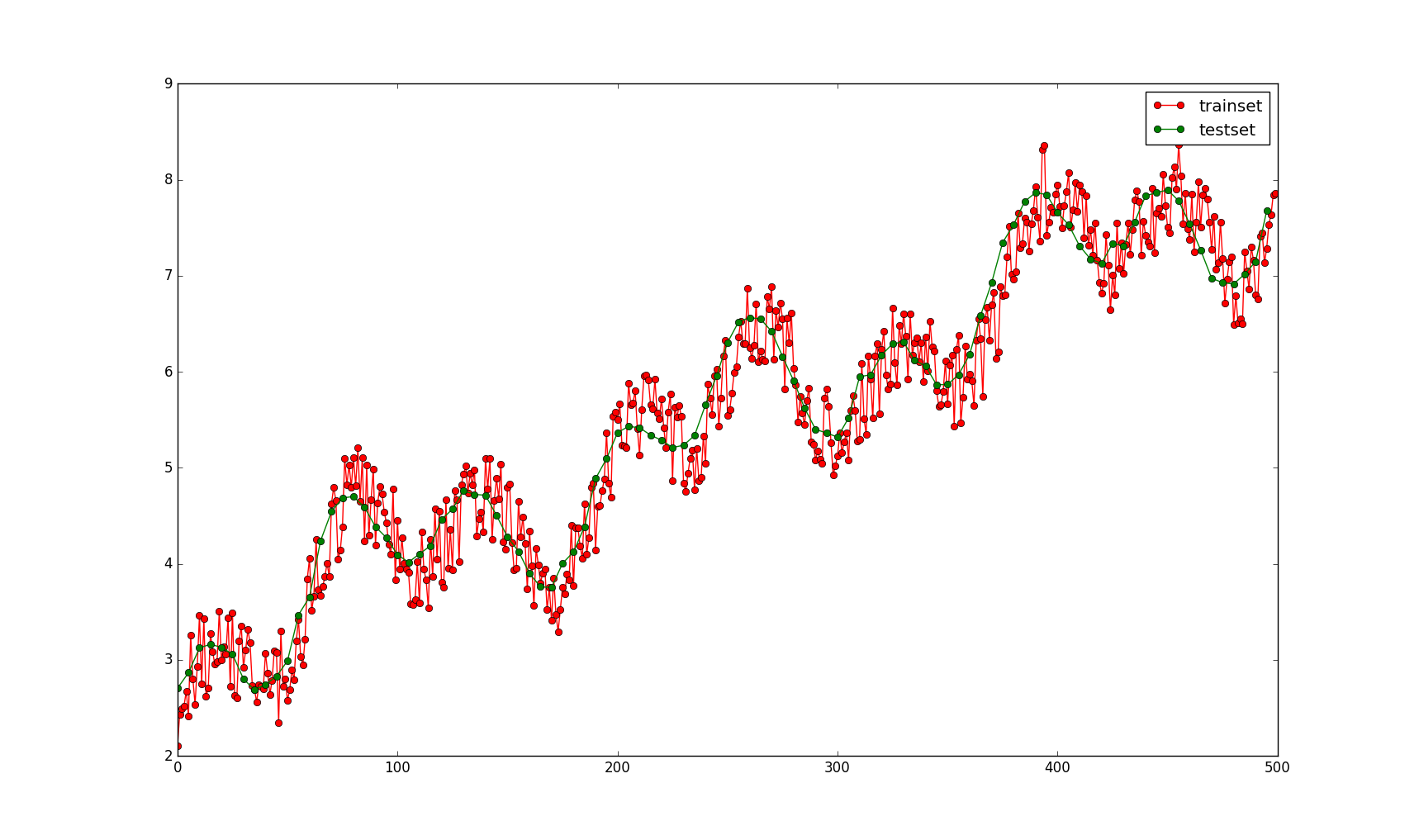

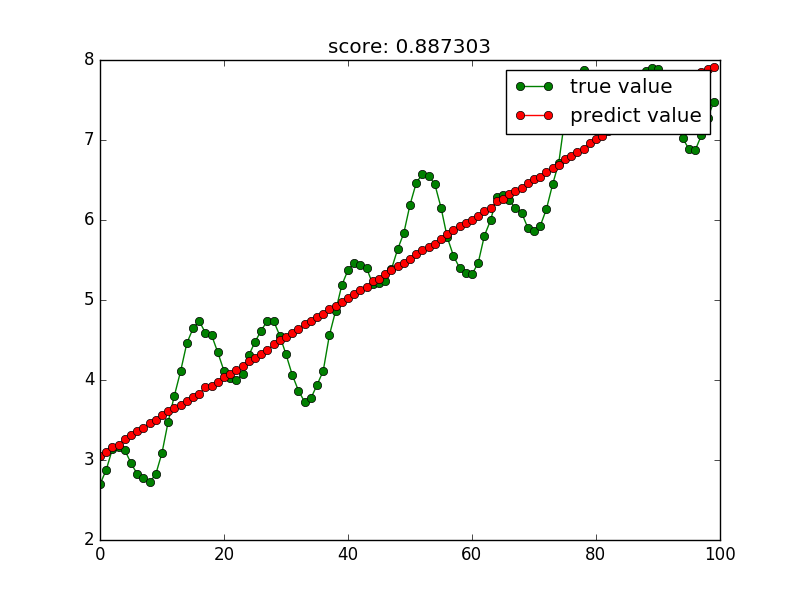
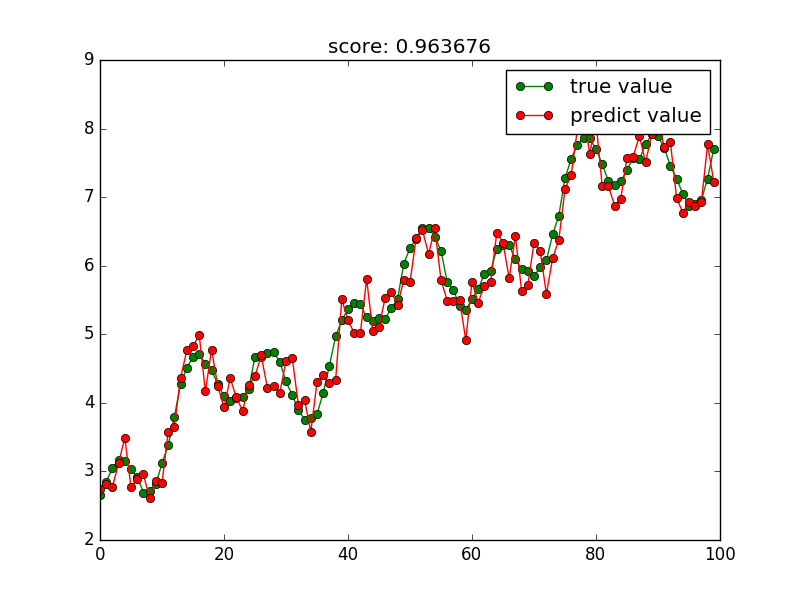
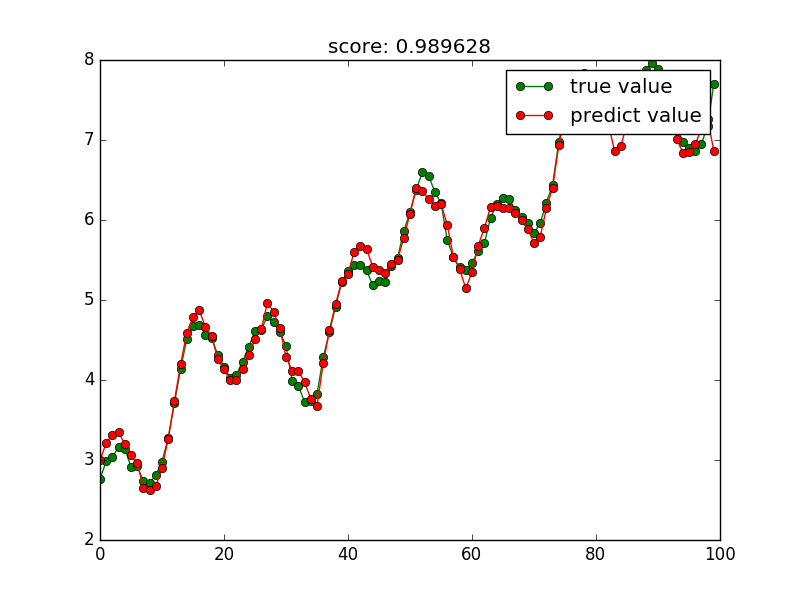
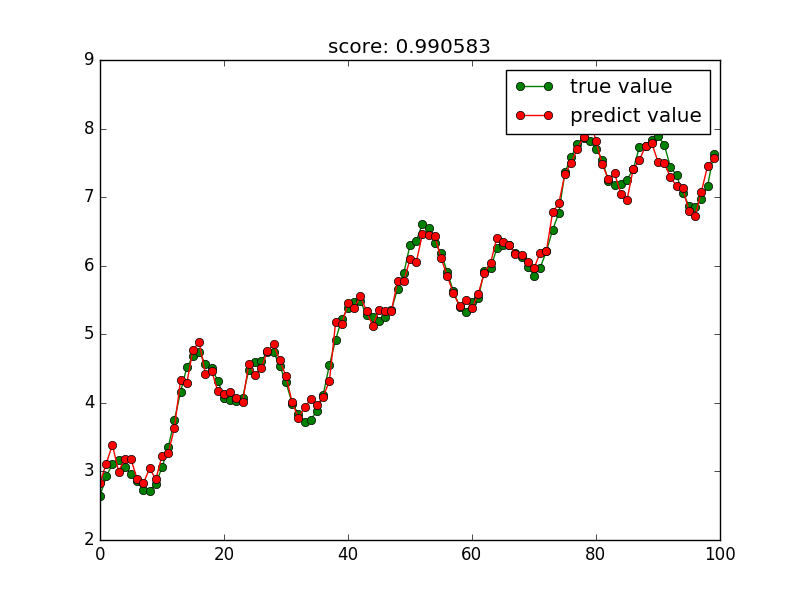
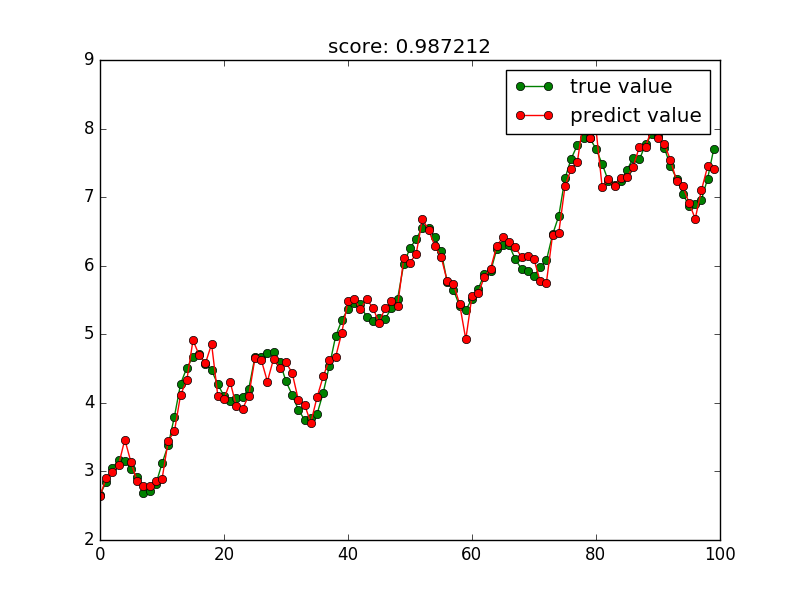
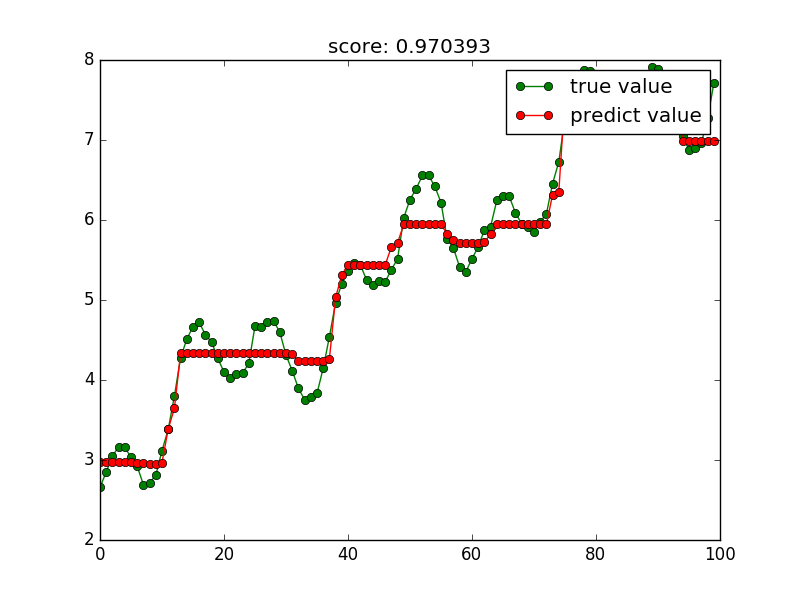
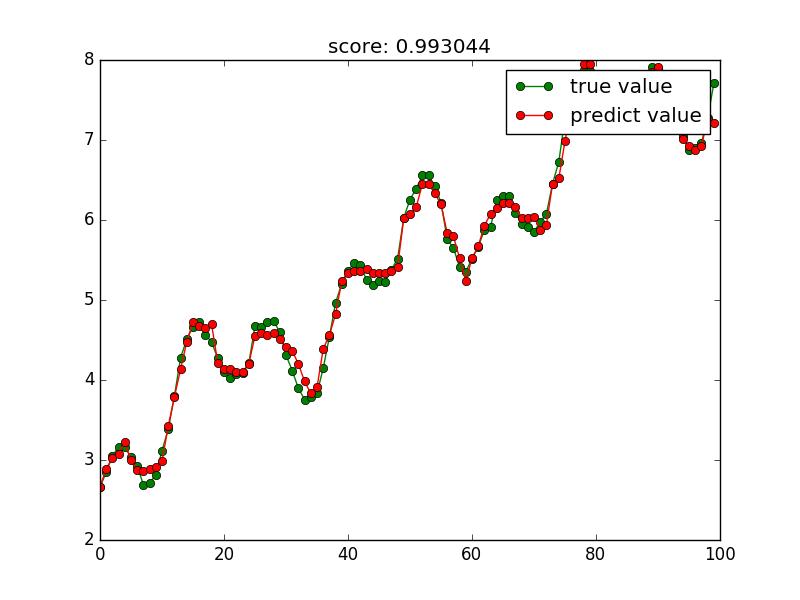













 4万+
4万+











 被折叠的 条评论
为什么被折叠?
被折叠的 条评论
为什么被折叠?








